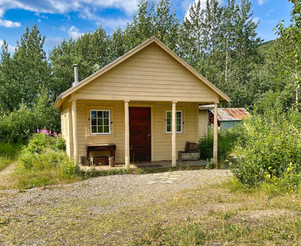Denali Days
- dougsmith51
- Jul 22, 2021
- 12 min read

NOTE: This is our third trip to Alaska. We first flew there in 1985, the year after we were married, and spent three weeks touring Alaska frugally, tent camping and backpacking. We returned in 2014 for a two week trip with our three sons. Those were both great trips, but we've relished the opportunity to explore Alaska in greater depth and at our leisure.

Having made it safely through Canada to the Alaskan border, we traveled on to Fairbanks to re-provision. For the first 100 miles or so, we continued to run into the frost heaves we'd experienced crossing through the Yukon, so it was sometimes slow going and took us till mid-afternoon to reach our destination. We'd eaten up most of our food since Canada had restrictions on bringing fresh food across the border, so we stopped by the Walmart in Fairbanks to fill back up. Our "Mister Heater" propane heater (which we use to keep warm when boondocking) had also given up the ghost, so we bought a replacement at Lowe's.
We overnighted at Pioneer Park, a history park run by the city (it was called "Alaskaland" when we were there in 1985). We decided to re-visit the "world famous" Alaska Salmon Bake, where they cook slabs of fresh-caught salmon slathered with brown sugar sauce. Delish!
We left in the morning on the 2.5 hr. drive to Denali Park and set up camp overnight just outside the park. On the drive south we were treated to tantalizing views of Denali on the horizon.
The park is one of the largest in the National Park system, but there is only a single road which goes into the interior of the park. Though the road is 92 miles long, it only reaches the park's center! Built in the 1920's, the first 13 miles are paved, the rest is gravel. People can only take their private vehicles on that first 13 miles. To see the rest of the park, you travel on buses managed by the Park Service. When we first visited Denali in 1985, we traveled on Fairbanks School District buses re-purposed for the summer. Now, there is a dedicated fleet of buses. Green buses provide the basic in-and-out tour services. There are also tan "guided tour" buses (we stuck to the green buses).


We had booked three nights at the Teklanika River campground in the park. It's at Mile 29, and if you have a reservation they will allow you to drive your RV beyond the normal 13-mile limit to the campground. However, you cannot bring any extra vehicles (we had to leave the Fittata by the visitor center), you need to stay for a minimum of three days, and once at the campground you cannot move your vehicle again until the end of your stay - no exploring the road! Instead, we would catch a green bus to explore the interior of the park.


The dirt road was not in great shape, with lots of washboarding, so it took us over an hour to make the 16 additional miles beyond the end of the paved road. However, we got our first view of Denali in the distance. Impressive, even though it was still 60 miles away!

We arrived at the campground around 11 am, and caught a bus at 1 pm to take us to the Eielson Visitor Center at mile 66, the farthest along the road the green buses typically go (it's an 8 hour roundtrip from the park entrance).
Although it's always a highlight to see "the mountain," it's typically only viewable about 30-40 percent of the time and socked in by clouds the rest of the time. During our 1985 Alaska visit, we spent an entire week in the park, and this is the only glimpse we got during the entire week:

Much of the fun of the ride out and back is looking for animals, especially the "Big 4:" moose, caribou, Dall sheep, and grizzly bears (there are also wolves, but they typically hang out in other parts of the park). In fact, Mount McKinley National Park (the park's old name) was established in 1917 not to showcase the mountain, but to protect the wildlife which were being decimated for food during the Alaskan gold rush.
During the rides in and out, bus passengers eagerly look out the windows on both sides, yelling "stop" when they see something. The bus will pause, and everyone flocks to that side of the bus with their binoculars and cameras. During our time in the park, we made three round trips in and were able to see all of the Big 4, although often in the distance rather than up close. We also saw smaller animals such as arctic ground squirrels, ptarmigans (a ground bird that is brown in summer and white in winter), a family of ravens, and sea gulls. We even saw a golden eagle perched high on a hillside.


One of the stops along the road is Polychrome Pass, which looks onto colorful mountains and two braided rivers crossing the tundra. It had been one of our favorite views during all our past visits to the park. On this visit, with sunny skies, the colors really came to life.

In 1985, we had backpacked into the country below Polychrome Pass. However, after a night of listening to the wolves howl, Jeannette requested that we end that portion of our trip early and retire to the Wonder Lake campground. It had taken us a while to hike back through tundra that tried to snag your legs, and then flag down a bus when we finally made it back to the road.
Right before Polychrome Pass, there is an area of the road that is "slumping" (see picture below). The permafrost underneath is melting due to global warming, and this summer that road surface had been sinking by more than 4 inches a day! The Park Service has an almost full-time operation trucking gravel to the road to help maintain the surface so buses can continue to drive on it. They will probably replace this section of the road with a bridge and have already started to survey the area. With the road essentially being only 1 lane wide, buses traveling in different directions would have to pull aside while the other bus went carefully by. We were glad that most of the bus drivers had been driving this road for 20+ years!

Other than the road, the scenery was spectacular! After crowning a road pass, the full expanse of Denali was on display. Just like our visit to Mount Rainier National Park, the massive mountain dominates the landscape. To our delight Denali was visible on our first trip out, although storm clouds were building on either side. On our second trip, the sky was nearly cloudless and we had an amazing view. Denali looks huge, even though it is still more than 30 miles from the roadway.


The views from the Eielson Visitor Center were even more spectacular, as you could see more mountains in the Alaska Range

Denali has a number of glaciers that flow down its sides. The one closest to the Eielson Visitor Center is the Muldrow Glacier that starts high on the mountain between the North and South peaks and flows into the valley. Although most glaciers worldwide are receding due to global warming, the Muldrow is experiencing a surge this year. A portion of this 34 mile long glacier is moving at a whopping 20 feet per day and shows little sign of stopping. It is easy to see the terminus of the glacier flowing into the valley in the picture below (it's a mixture of light ice and dark rock covering some of that ice). Park rangers monitoring the surge report that the sliding and cracking ice creates constantly booming thunder sounds. The black surface on top of the ice is rock and debris created as the heavy ice breaks up the rocky surface below and as the ice melts, the rock encased in it stays on the surface. The surge is caused by the rapid movement of the top of the glacier down the face of Denali. The fast flowing river of ice will leave a "bathtub ring" near the top of the mountain where the upper glacier has "drained out" and cascaded into the valley below.

At a scheduled return stop near the Toklat River, Doug experimented with his inner wild animal.
Back at the Teklanika campground, we sat outside our rig and enjoyed basking in the sun at 10pm at night! We'd set up a portable solar panel to help keep the batteries charged since we were boondocking. Our rig, with its Virginia license plates, was a source of great curiosity to fellow campers, most of whom were from Alaska or had rented RVs in Alaska. We recounted our ferry adventures and passage through Canada many times. There were tons of kids riding around the campground on their bikes (a dozen Anchorage-based families had made reservations back in February to come up to Teklanika together) and the people were among some of the friendliest we've experienced during our RV travels.

During our second day at the campground we decided to stay local and hike along the Teklanika River. Like many Alaskan rivers, it has a wide gravel bed formed during the last ice age. The river itself flows through the gravel bed, changing its course as the water level rises and falls - Alaskans call this a "braided river" due to its appearance.
Since the river originated high in the mountain glaciers, the water had a blue-grey cast to it. The color was due to the finely-ground glacial powder created as the weight of the moving glacier scrapped the bedrock underneath. Beautiful flowering bushes grew up in the streambed.

On our hike, we met up with one of the campground families we'd befriended (he works for the Forest Service, she for the Park Service) and spent some time talking with their daughter Cora, a very precocious three-year old.

Denali National Park has several different mountain ranges of different ages, colors, and compositions. The Alaska Range is about 100 million years old. Other mountains are as much as 500 million years old. We were amazed at the variety of rocks and pebbles that lined the Teklanika River valley.
On our last full day at the campground, we saw that the sky was blue and the wind (which had been whipping during our first day) was much calmer, so we flagged down a green bus for our second trip out to the Eielson Visitor Center. The mountain was out in its full glory!

We stayed at the visitor center for an extra hour so we could attend a Ranger-led walk in the area. Her topic was wolverines, wild animals rarely seen in the park but with amazing superpowers (e.g., they can smell more than 20 feet down into a snow bank, they can bring down an adult caribou even though they are much smaller, and each wolverine has a territory of 100-300 square miles).

At the visitor center, there is a set of interlocked moose horns. Two bull males had been fighting during the mating "rut", and rammed so hard their racks stuck together and they could not break loose. Their antlers were found like this the next spring (along with the moose skeletons).

On the trip back, we had to delay at the Toklat River rest stop for 1.5 hours due to road construction in the area. We walked down by the river, and were rewarded when a male caribou walked by us no more than 30 feet away! Other caribou had walked through the area recently, including a mother and her calf.
The next morning we left Teklanika and drove the bumpy road back out to the park entrance, moving into a commercial RV campground so we could dump our tanks, refill our water, and recharge our batteries. Some of our friends from the ferry were in the area, and we all went out to dinner together at a local restaurant.
The following day, we left our RV and car near the Alaska Railroad station (which is near the park visitor center) and boarded a bus to the Kantishna Roadhouse, a privately-operated lodge (one of three lodges) located near the end of the 93 mile park road. We'd spent two nights there during our 2014 Alaska visit with our sons and wanted to go back. It's the only way to get to the end of the road and see beautiful Wonder Lake, the scene of many pictures of Denali reflected in its clear waters.
Unfortunately, during our time there the sky was gray with low hanging clouds, so we did not get to see Denali.

We had a nice visit nonetheless. We did a three mile hike on a gravel road along Moose Creek, splashing through submerged sections (the Roadhouse provided "Alaskan Sneakers," a.k.a. rubber boots, for everyone). We saw a beaver lodge and dam near the creek.

Doug took a side trip to the cabin of Fanny Quigley, a woman who had come up with the gold miners and then decided to stay in the area until she died in 1944. The Park Service maintains her cabin as a historic site. Fanny and her husband had ordered the house structure out of the Sears Catalog.
While Doug was visiting the Quigley cabin, Jeannette decided to try her hand at fly fishing, and got one of the guides to show her some basic techniques (you can see below how good she looks in Slo-Mo).
One downside of our visit to the Roadhouse was that the place was overrun by yellowjackets, and they managed to squeeze through cracks into our cabin. Thoughtfully, the Roadhouse had provided bug zappers and we had a great time frying the yellowjackets and the local mosquitos.
The evening before we left, one of the guides gave a presentation on preparing for a Denali summit climb, something she was hoping to do in May 2022. The typically summit attempt starts by flying onto a glacier at about 7,000 feet, and takes 2-4 weeks total. Denali is more than 20,000 feet tall, and is one of the world's tallest in terms of rising 18,000 above its surrounding landscape (Everest only rises 12,000 feet above its landscape).
Afterward, we took a van trip to nearby Wonder Lake. Although the lake was beautiful as always, we were not able to see the famous reflection of the Alaska Range that the lake is famous for (we'd lucked into that view during our 2014 visit).

We woke early the next morning and left the Roadhouse on a 6:15 am bus. Our driver had been taking guests to the Roadhouse for almost 30 years and regaled us with some of her adventures.
We picked up our car at the railroad station and drove back along the paved part of the Park Road to the Savage River area (site of some of the oldest rocks in the park). We took a nice loop hike along both sides of the river as it plunged into a narrow gorge. There's an interesting rock formation, sometimes called Savage Man, that looks likes the head of a sleeping (snoring) man lying on his back.

Leaving Denali NP, we drove south to Denali State Park, which hugs the southern border of the national park.
Denali State Park has terrific views of Denali and the Alaska Range mountains. However, wildfires to the west of the national park had thrown a lot of smoke up in the air, and you could barely see the mountain from the highway. The online EPA Fire and Smoke map confirmed that we were in the thick of it.
We overnighted in the K'esugi Ken campground (which had electricity) and then moved 10 miles north for a three day stay at the Byer Lake campground in the state park. We'd been on the go for many days, and thought a few days of relaxation would be in order. But not quite yet...
Although smoky, the skies were cloudless, and on a whim we decided to take a flightseeing tour of Denali on an airplane operated by K2 Aviation, located about an hour south of us in Talkeetna. This is clearly a very popular activity as four planes, each with 8 passengers, took off in quick succession. Jeannette managed to grab the co-pilot seat on our flight to the mountains.

From the air, you really get a feeling for just how huge the mountains in the Alaska range are, and how long the major glaciers are (some exceed 30 miles in length). The smoke obscured our views a bit, but we were still awed by the views.

The highlight of our flight was landing on the Ruth Glacier (click the picture below to see the video). If you look carefully, you will see another plane taking off as we land - it's so tiny against the cliffs, it gives a sense of scale to the scenery.
Fortunately, there was no wind and the weather was mild, so we were able to get out of the plane for about 15 minutes. There was a lot of selfie and group photo taking.

We could also see a cabin up on one of the rock walls - that turned out to be a private inholding built in 1968. You can rent it for a mere $40,000/night (includes transportation to and from).

We returned to the plane, took off, and returned to Talkeetna airfield. The whole flight, including the glacier landing, lasted almost two hours.
On our drive back to the campground at 11:00 pm, the sun was still up, but darkened by smoke.

Then it WAS time to relax, and we spent the next two days hanging around the RV, experimenting with our Thermocell Backpacker Mosquito Repeller (it worked!), napping, eating a sous vide filet mignon dinner, and generally winding down.
We got our our inflatable kayak, and had two paddling sessions on Byers Lake. We were impressed by the "Kids Don't Float" life jacket inventory available by the beach/boat ramp, a service of the state parks department across the state.
Although it's possible to see Denali from the lake, clouds and smoke obscured that for us. However, we did run into two trumpeter swans and their cygnets. We also ran into two loons and their babies (What do you call baby loons? Loonies? Loonettes? Fruits of the Loon?).


It was time to move on! We packed up, left the campground, and headed south toward Anchorage for more adventures! Stay tuned for those adventures in our next blog post.











































































































Wildly spectacular!! Thanks for the trip in and around Denali!